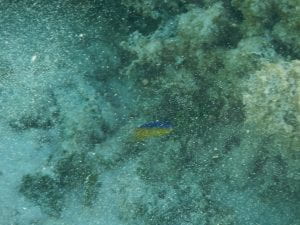May 22nd, 2019
Today we left The Tropical Education center to embark on our journey to Glover’s Reef, a world heritage site and atoll, off the coast of Belize. The boat ride was three hours and the scenery around us was breathtaking. The water color changed from the marina brown, to a seafoam green, to a pure aqua. As the land disappeared behind us and when we crossed a barrier reef, the water below turned a deep dark blue. Soon the reefs of Glover’s came into view along with the island we would be staying on, Middle Caye at a WCS marine research station. We dropped off our bags in our dorms and were given a tour of the station. After a short tour and a little talk about the composting toilets they have, each called Clivus, we ate lunch. The food was amazing and after that we went on a snorkel to test out our gear.
It was honesty great to be in the water again and the water was as warm as heated pool water. We were going to try and swim to a patch reef near island, but due to some equipment difficulties in the group we had to swim back to the dock. Even at/near the dock there were groups of yellowtail snapper, and some upside-down jellyfish. Thinking that the current would be less and the wind more or less null we traversed the “Mangroves of Death” to get to the leeward side of the island. The “Mangroves of Death” we soon found out are infested with mosquitoes and biting flies. Everyone ran through the mangroves, careful not to trip but fast enough to evade the mosquitoes, but it was to no avail. All of us ended up getting bit, myself getting upwards of 20 bites on my back. Once we reached the water, we shuffled through some sea grass and made looked at some very shallow coral beds. For this portion of the course I’m the expert on herbivorous fish, and I saw a couple species today. In essence, herbivorous fish are fish that eat algae or vegetation, however some of them can be omnivores. Today I saw what appeared to be a very small juvenile Dusky Damselfish. It has a white lower body and a bright orange body, complete with blue spots on its head. I also saw what appeared to be a small Ocean Surgeonfish, these fish eat the algae off coral and are bluish grey in color.
After that excursion, we made a mad dash through the death mangroves and eventually reached the station. We washed off our equipment with freshwater and after dinner, which consisted of tender chicken with rice and lemon pie, we ended the day with presentations on sponges, coral, and the different kinds of microbes in coral reefs.

